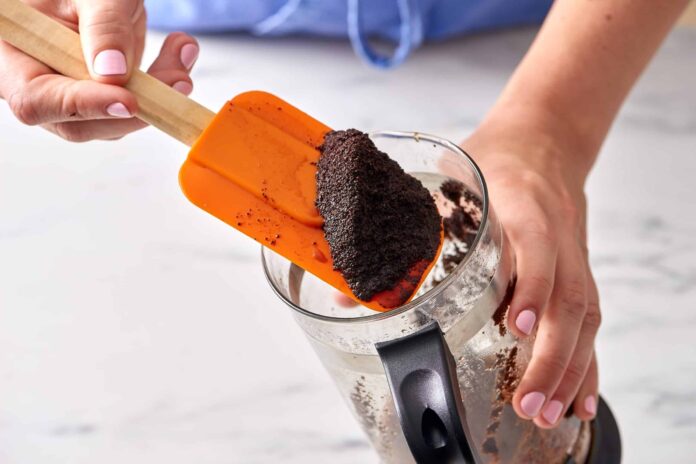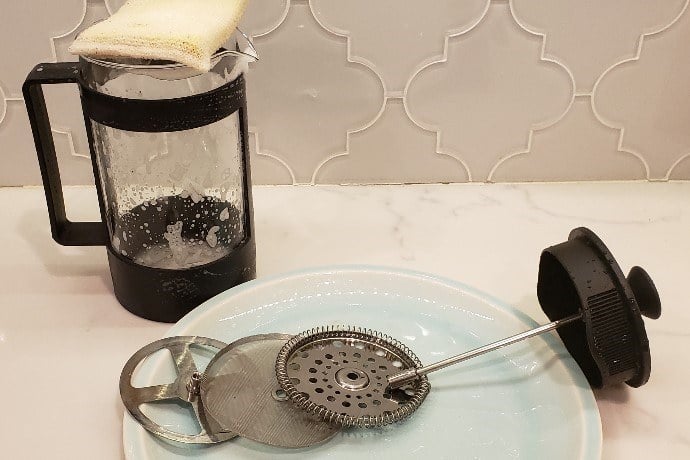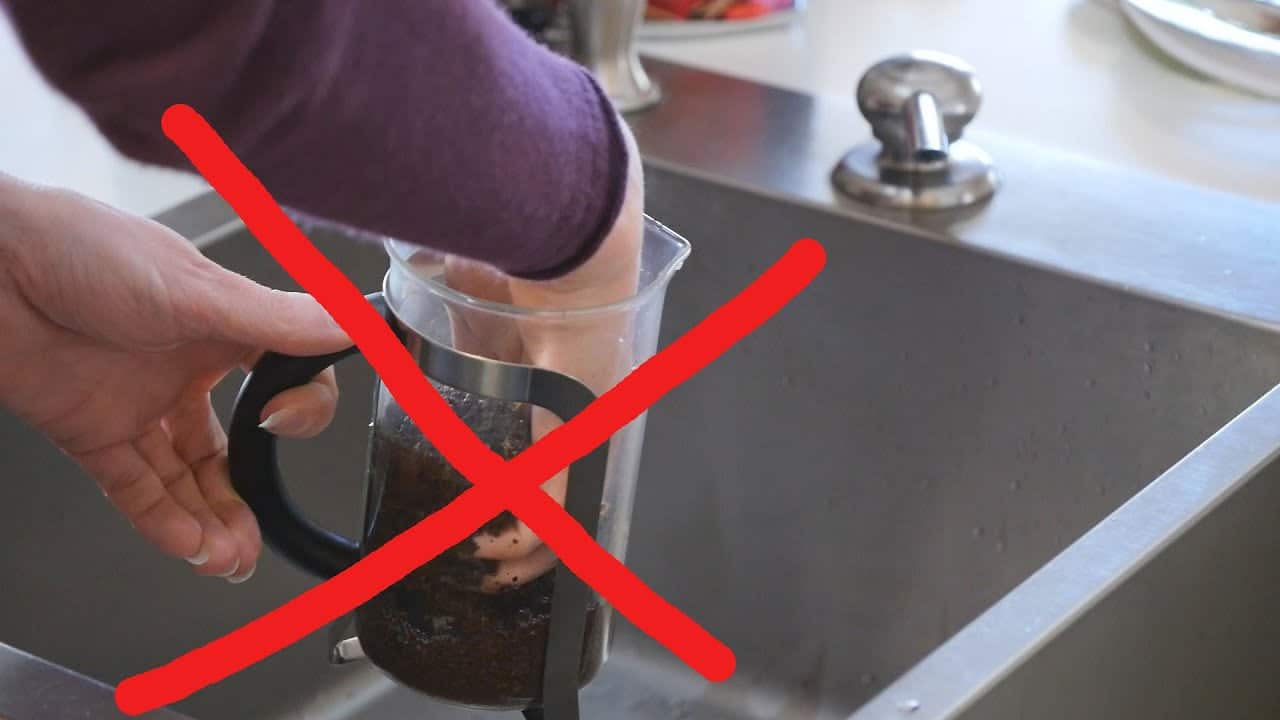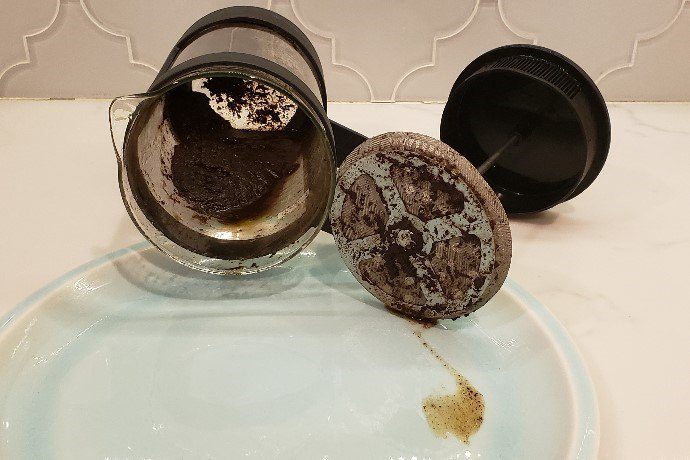In this article, we will offer an easy and effective method to clean your French press. We understand that maintaining the cleanliness of this popular coffee brewing device can be a bit tricky, but fret not! We have got you covered. With our simple step-by-step guide, you’ll have your French press sparkling clean and ready to brew your next delicious cup of coffee in no time. So, if you’ve been wondering how to tackle the task of cleaning a French press, keep reading for our expert tips and tricks. Cleaning a French press is an essential part of ensuring that you have a delicious and fresh cup of coffee every time. Daily cleaning, disassembly, rinsing, scrubbing, removing coffee residue, cleaning the plunger, cleaning the filter screen, cleaning the glass carafe, cleaning the lid and handle, and deep cleaning are all important steps in maintaining your French press. Let’s dive into each of these steps and explore how to clean a French press effectively.
Daily Cleaning
Daily cleaning is the first step in maintaining a clean French press. It helps to remove any leftover coffee residue and prevents it from building up over time. Here are the steps for daily cleaning:
Emptying the Residual Coffee
Start by emptying the remaining coffee grounds from the French press. Make sure to discard them in a compost or trash bin. Avoid pouring coffee grounds down the sink, as they can clog the drain.
Rinsing with Warm Water
Next, rinse the French press with warm water to remove any loose coffee grounds. This will also help to loosen any stubborn residue before further cleaning.
Cleaning the Plunger
Pay special attention to the plunger, as it tends to collect the most residue. Use a soft sponge or brush to scrub the plunger thoroughly. Rinse it under warm water to remove any remaining debris.
Disassembly
Disassembling the French press allows for a more thorough cleaning of each individual component. It ensures that no hidden residue is left behind. Here’s how you can disassemble your French press:
Removing the Plunger
Start by removing the plunger from the French press. Gently push it down and twist it counterclockwise to detach it from the lid.
Dismantling the Filter Screen
Take apart the filter screen by unclipping it from the plunger rod. Depending on your French press model, you may need to unscrew or detach other parts to access the filter screen fully.
Taking Apart the Lid and Handle
Separate the lid and handle from the glass carafe. Some French press models have lids and handles that can be easily detached, while others may require unscrewing or unclipping.
Rinsing
Rinsing is an important step to remove any loose debris and prepare the French press for further cleaning. Let’s look at how to rinse each component effectively:
Rinsing the Plunger and Filter Screen
Place the plunger and filter screen under warm running water, gently agitating them to dislodge any remaining coffee residue. Pay close attention to the filter screen, as it can easily get clogged with fine grounds.
Rinsing the Glass Carafe
Hold the glass carafe under warm running water and allow it to fill up to rinse away any coffee residue. Swirl the water around inside the carafe to ensure a thorough rinse.
Rinsing the Lid and Handle
Hold the lid and handle under running water, ensuring every part is rinsed well. This will remove any residual coffee oils or dirt that may have accumulated.
Scrubbing
Scrubbing is necessary to remove stubborn stains and ensure a clean French press. Use these techniques to effectively scrub each component:
Using a Soft Sponge or Brush
A soft sponge or brush is ideal for scrubbing the various parts of the French press. It helps to remove coffee stains without scratching or damaging the surfaces.
Removing Stains
For stubborn stains, you can use a mixture of warm water and mild dish soap. Apply the soapy solution to a sponge or brush and scrub the stained areas gently. Rinse thoroughly afterward.
Cleaning the Plunger Rod
To clean the plunger rod, apply some dish soap to a sponge or brush. Scrub the rod thoroughly, paying attention to the areas that make contact with the filter screen. Rinse the plunger rod under warm water to remove all traces of soap.
Removing Coffee Residue
Coffee residue can build up over time and affect the flavor of your freshly brewed coffee. Here are different methods to effectively remove coffee residue from your French press:
Using Dish Soap
Add a few drops of mild dish soap to warm water and mix well. Submerge the French press components in the soapy water and let them soak for a few minutes. Scrub each part with a sponge or brush, paying extra attention to areas with stubborn residue.
Using Baking Soda
Create a paste by mixing baking soda with a little water. Apply the paste to a soft sponge or brush and scrub the French press components gently. Baking soda is a natural abrasive that helps remove stuck-on residue.
Using Vinegar
Alternatively, you can use vinegar to remove coffee residue. Fill the French press with equal parts water and vinegar and let it sit for about 10-15 minutes. Scrub the components with a sponge or brush, paying attention to any stained areas. Vinegar helps to dissolve and remove built-up oils and stains.
Cleaning the Plunger
The plunger is where most of the residual coffee grounds tend to accumulate. It is essential to clean it thoroughly for optimal performance and coffee flavor. Here’s how to clean the plunger effectively:
Separating the Plunger Components
Disassemble the plunger by removing any removable parts, such as the filter screen or additional layers. This will allow for a more thorough cleaning of each component.
Scrubbing the Plunger Parts
Using a soft sponge or brush, scrub each part of the plunger, paying attention to any buildup or stains. Make sure to clean both the external and internal surfaces to ensure a comprehensive clean.
Rinsing and Drying
Rinse the plunger components under warm water, ensuring that all traces of soap or cleaning solutions are removed. After rinsing, allow the parts to air dry completely before reassembling the plunger.
Cleaning the Filter Screen
The filter screen is responsible for keeping coffee grounds out of the final cup. However, it can become clogged with oils and residue over time. Follow these steps to clean the filter screen effectively:
Disassembling the Filter Screen
Separate the filter screen from the plunger rod, ensuring that all clips or fasteners are unclipped. This will give you better access to the individual components.
Cleaning with Warm Water
Rinse the filter screen under warm water, gently rubbing and agitating it to remove any loose debris. Pay attention to the tiny mesh openings, as they can easily trap coffee grounds.
Removing Coffee Oils with Dish Soap
Create a soapy solution by mixing warm water with a few drops of dish soap. Submerge the filter screen in the soapy water and let it soak for a few minutes. Rinse thoroughly afterward to remove any soap residue.
Rinsing and Drying
Thoroughly rinse the filter screen under warm running water, ensuring that all soap is washed away. Shake off any excess water and allow the filter screen to air dry completely before reassembling it.
Cleaning the Glass Carafe
The glass carafe is where the brewed coffee is stored, making it important to keep it clean to maintain the coffee’s flavor and aroma. Here’s how to clean the glass carafe effectively:
Filling the Carafe with Warm Water
Fill the glass carafe with warm water, ensuring that it covers all interior surfaces. This will help to loosen any residue or stains.
Using Dish Soap or Baking Soda
Add a small amount of mild dish soap or baking soda to the warm water in the carafe. Mix it well to create a soapy solution that will help remove any coffee stains.
Scrubbing the Interior
Use a sponge or brush to scrub the interior of the carafe, paying attention to any stained areas. Gently scrub in circular motions to ensure a thorough cleaning.
Rinsing and Drying
After scrubbing, rinse the carafe under warm running water to remove any traces of soap or cleaning solution. Make sure to rinse thoroughly to avoid any lingering flavors. Allow the carafe to air dry completely before using it again.
Deep Cleaning
Deep cleaning your French press is an occasional task that helps remove mineral deposits and stubborn stains. Here’s how to perform a deep clean:
Descaling with Vinegar
If your French press has mineral deposits or limescale buildup, you can use vinegar to descale it. Fill the French press with equal parts water and vinegar, and let it sit for a few hours or overnight. Rinse thoroughly afterward to remove any vinegar residue.
Using Citric Acid Solution
Alternatively, you can use a citric acid solution to descale your French press. Follow the instructions on the citric acid package to create a solution. Submerge the components in the solution and let them soak for a few hours or overnight. Rinse thoroughly afterward.
Soaking the Components
To remove any stubborn stains or residue, you can soak the French press components in warm water and dish soap or baking soda. Let them soak for a few hours or overnight, depending on the severity of the stains.
Scrubbing Stubborn Stains
After soaking, scrub the components with a sponge or brush to remove any remaining stains or residue. Pay special attention to areas with stubborn buildup.
Rinsing and Drying
Thoroughly rinse all the components under warm water, ensuring that all traces of cleaning solutions are removed. Allow them to air dry completely before reassembling the French press.
In conclusion, cleaning a French press is crucial for maintaining the quality and taste of your coffee. By following these comprehensive steps for daily cleaning, disassembly, rinsing, scrubbing, removing coffee residue, cleaning the plunger, cleaning the filter screen, cleaning the glass carafe, cleaning the lid and handle, and deep cleaning, you can ensure that your French press remains in excellent condition, delivering delicious cups of coffee for a long time to come. So, grab your cleaning supplies and start cleaning your French press today for a consistently perfect coffee experience!









































